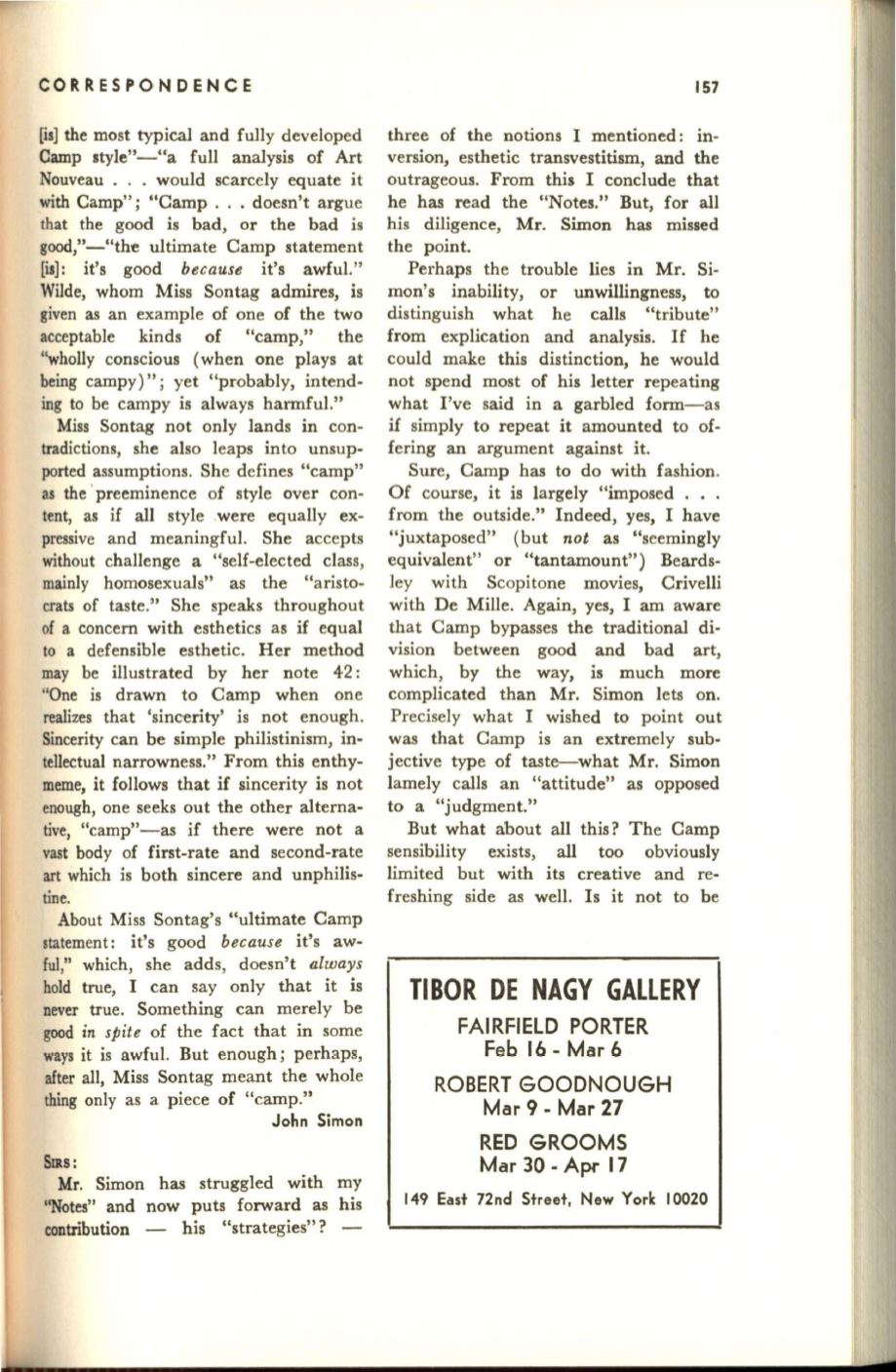
CORRESPONDENCE
[is] the most typical and fully developed
Camp style"-"a full analysis of Art
Nouveau . . . would scarcely equate it
with Camp"; "Camp . . . doesn't argue
that the good is bad, or the bad is
good,"-"the ultimate Camp statement
[is]: it's good
because
it's awful."
Wilde, whom Miss Sontag admires, is
given as an example of one of the two
acceptable kinds of "camp," the
"wholly conscious (when one plays at
being campy)"; yet "probably, intend–
ing to be campy is always harmful."
Miss Sontag not only lands in con–
tradictions, she also leaps into unsup–
ported assumptions. She defines "camp"
as the 'preeminence of style over con–
tent, as if all style .were equally ex–
pressive and meaningful. She accepts
without challenge a "self-elected class,
mainly homosexuals" as the "aristo–
crats of taste." She speaks throughout
of a concern with esthetics as
if
equal
to a defensible esthetic. Her method
may be illustrated by her note 42:
"One is drawn to Camp when one
realizes that 'sincerity' is not enough.
Sincerity can be simple philistinism, in–
tellectual narrowness." From this enthy–
meme, it follows that if sincerity is not
enough, one seeks out the other alterna–
tive, "camp"-as if there were not a
vast body of first-rate and second-rate
art which is both sincere and unphilis–
tine.
About Miss Sontag's "ultimate Camp
statement: it's good
because
it's aw–
ful," which, she adds, doesn't
always
hold true, I can say only that it is
never true. Something can merely be
good
in spite
of the fact that in some
ways it is awful. But enough ; perhaps,
after all, Miss Sontag meant the whole
thing only as a piece of "camp."
John Simon
Sms:
Mr. Simon has struggled with my
"Notes" and now puts forward as his
contribution -
his "strategies" ?
157
three of the notions I mentioned: in–
version, esthetic transvestitism, and the
outrageous. From this I conclude that
he has read the "Notes." But, for all
his diligence, Mr. Simon has missed
the point.
Perhaps the trouble lies in Mr. Si–
mon's inability, or unwillingness, to
distinguish what he calls "tribute"
from explication and analysis.
If
he
could make this distinction, he would
not spend most of his letter repeating
what I've said in a garbled form-as
if simply to repeat it amounted to of–
fering an argument against it.
Sure, Camp has to do with fashion .
Of course, it is largely "imposed . . .
from the outside." Indeed, yes, I have
"juxtaposed" (but
not
as "seemingly
equivalent" or "tantamount") Beards–
ley with Scopitone movies, Crivelli
with
De
Mille. Again, yes, I am aware
that Camp bypasses the traditional di–
vision between good and bad art,
which, by the way, is much more
complicated than Mr. Simon lets on.
Precisely what I wished to point out
was that Camp is an extremely sub–
jective type of taste-what Mr. Simon
lamely calls an "attitude" as opposed
to a "judgment."
But what about all this? The Camp
sensibility exists, all too obviously
limited but with its creative and re–
freshing side as well.
Is
it not to be
TIBOR DE NAGY GALLERY
FAIRFIELD PORTER
Feb 16 - Mar 6
ROBERT GOODNOUGH
Mar 9 - Mar 27
RED GROOMS
Mar 30 - Apr 17
149 East 72nd Street, New York 10020


